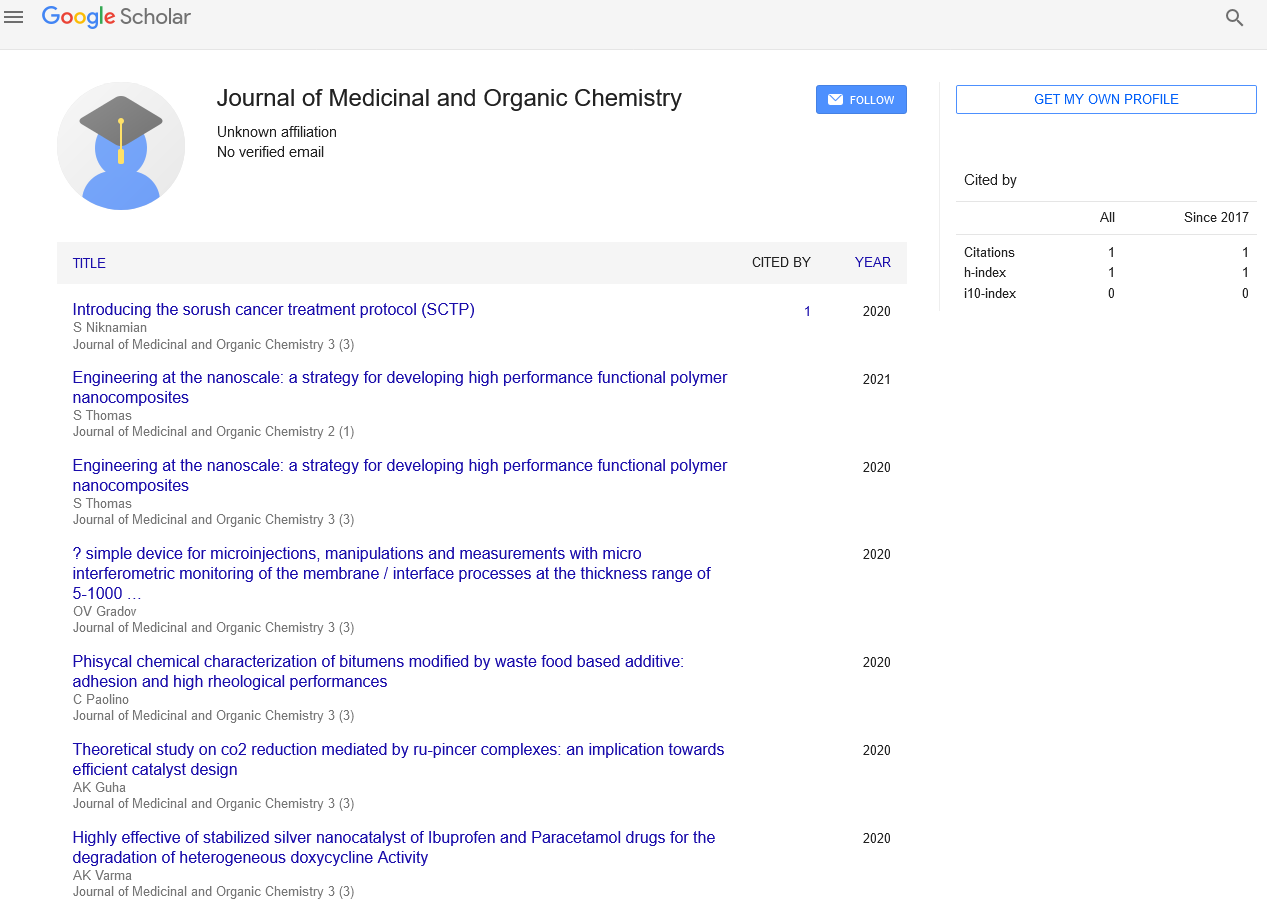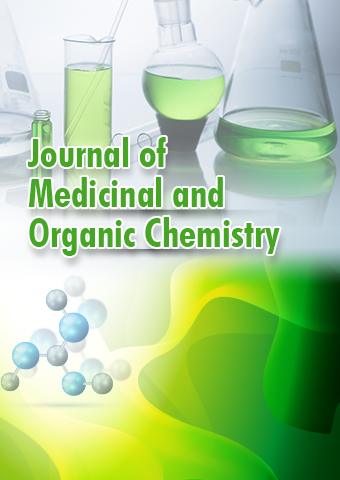Review Article - Journal of Medicinal and Organic Chemistry (2023) Volume 6, Issue 3
Chemical Libraries: Unlocking the Power of Molecules
Dr. Stefan Suzuki*
Department of Electronics Molecules and Tropical Medicine, UK
Department of Electronics Molecules and Tropical Medicine, UK
E-mail: stefan.s@gmail.com
Received: 02-June-2023, Manuscript No. jmoc-23-101940; Editor assigned: 05-June-2023, PreQC No. jmoc-23-101940; Reviewed: 19-June-2023, QC No. jmoc-23-101940; Revised: 23-June-2023, Manuscript No. jmoc-23-101940 (R); Published: 30-June-2023, DOI: 10.37532/2023.jmoc.6(3).46-49
Abstract
Chemical libraries play a pivotal role in drug discovery and development, serving as valuable resources for scientists in their quest to identify new therapeutic agents. These vast collections of small molecules provide a treasure trove of chemical diversity, allowing researchers to screen for compounds that have the potential to interact with biological targets and modulate disease processes. In this article, we will explore the concept of chemical libraries, their design and generation, and their significance in modern drug discovery. Chemical libraries, also known as compound libraries or small molecule libraries are extensive collections of diverse chemical compounds that are systematically stored and made available for screening purposes. These libraries consist of small organic molecules, typically with molecular weights less than 900 Daltons, and are designed to encompass a broad range of chemical structures and properties. Chemical libraries play a crucial role in drug discovery and development, providing a vast collection of small molecules that can be screened against specific biological targets. These libraries are diverse in their chemical structures and have been designed to cover a wide range of chemical space. In this abstract, we explore the concept of chemical libraries, their construction methods, and their applications in drug discovery. We discuss the importance of diversity and complexity in chemical libraries, as well as the advancements in high-throughput screening technologies that enable efficient and rapid screening of large libraries. Furthermore, we highlight the challenges and strategies involved in the synthesis and management of chemical libraries. Overall, chemical libraries serve as valuable resources for identifying novel drug candidates and accelerating the discovery of new therapeutic agents.
Keywords
Chemical libraries • Drug discovery • Small molecules • High-throughput screening • Diversity • Complexity • Synthesis • Management • Therapeutic agents • Industry
Introduction
Chemical libraries play a vital role in the field of drug discovery and development. They are vast collections of small molecules that serve as valuable resources for researchers seeking to identify new therapeutic agents and probe biological processes. These libraries consist of diverse chemical structures, providing a wide range of potential drug candidates for screening and optimization [1]. The concept of chemical libraries emerged from the realization that exploring a vast chemical space is crucial for finding novel compounds with desirable biological activities. By systematically synthesizing and assembling large collections of molecules, scientists have been able to access an expansive repertoire of chemical diversity. These libraries are designed to encompass various structural classes, functional groups, and chemical properties, enabling researchers to explore a wide range of molecular possibilities [2].
The construction of chemical libraries relies on diverse synthetic methodologies, such as combinatorial chemistry and parallel synthesis, which allow for the rapid production of thousands or even millions of compounds. These compounds are typically small molecules, ranging from a few atoms to several hundred atoms in size, and can be derived from natural sources, modified natural products, or entirely synthetic compounds. Each member of a chemical library represents a unique chemical entity, offering the potential for novel interactions with biological targets [3]. Chemical libraries serve as valuable resources for high-throughput screening (HTS) campaigns, where thousands or millions of compounds are tested against specific biological targets or disease models. HTS involves automated assays that evaluate the ability of each compound in the library to interact with a target of interest, such as an enzyme, receptor, or protein. By analysing the results of these screens, researchers can identify hit compounds, which are initial leads that exhibit promising biological activity. The primary objective of chemical libraries is to provide researchers with a vast array of molecules that can be screened against specific biological targets or disease models. By testing large numbers of compounds, scientists can identify potential hits or leads, which are compounds that exhibit desired interactions or activities. These hits can then be further optimized and developed into therapeutic candidates [4].
Once hit compounds are identified, medicinal chemists and drug designers can further optimize their properties through a process known as lead optimization. This involves modifying the chemical structure of the hit compounds to improve their potency, selectivity, pharmacokinetic properties, and safety profiles. Chemical libraries provide a rich source of structural diversity from which lead optimization efforts can draw inspiration, facilitating the development of more effective and safer drug candidates [5].
Furthermore, chemical libraries are not limited to drug discovery alone. They also find applications in various fields, including agrochemicals, materials science, and chemical biology. Researchers can exploit the vastness and diversity of chemical libraries to address diverse challenges, ranging from crop protection to the development of new materials with specific properties.
Design and generation of chemical libraries
Chemical libraries are generated through a combination of synthetic chemistry, natural product isolation, and highthroughput screening methods. There are two main approaches to creating chemical libraries: diversity-oriented synthesis (DOS) and focused libraries. Diversity-oriented synthesis involves the systematic synthesis of structurally diverse compounds [6]. This approach aims to cover a wide chemical space, providing a broad sampling of potential interactions with biological targets. DOS libraries are often generated using combinatorial chemistry techniques, where multiple reactions are performed in parallel to create large numbers of compounds. These libraries can be designed based on specific structural features or molecular scaffolds.
Focused libraries, on the other hand, are designed to target specific classes of biological targets or disease pathways. These libraries are created by modifying existing compounds or scaffolds to enhance their potency, selectivity, or pharmacokinetic properties [7]. Focused libraries can be derived from natural products, which are compounds isolated from natural sources such as plants, marine organisms, or microorganisms. Natural product libraries have been a valuable source of bioactive compounds throughout the history of drug discovery. In addition to synthetic and natural product libraries, virtual libraries are becoming increasingly important in the field of drug discovery. Virtual libraries are computer-generated collections of compounds that are created based on algorithms and computational modelling. These libraries can be screened virtually to identify potential hits, which can then be synthesized and tested in the laboratory [8].
Screening and hit validation
Chemical libraries are typically screened using high-throughput screening (HTS) techniques, which enable the rapid testing of thousands to millions of compounds against specific biological targets. HTS assays are designed to measure the interaction between a compound and its target, whether it is an enzyme, receptor, or other biomolecule involved in disease pathways [9].
HTS assays can be designed to measure various types of interactions, such as enzyme activity, receptor binding, cellular signalling, or cell viability. These assays are often performed in microtiter plates, with each well containing a different compound from the library. Automated liquid handling systems and robotics are utilized to carry out the screening process efficiently.
The primary output of an HTS campaign is a list of compounds that show activity or desired interactions with the target of interest. These compounds, known as hits, require further validation and characterization to confirm their activity and assess their potential as leads for drug development. Hit validation involves evaluating the hits in secondary assays to confirm their activity and specificity [10]. These secondary assays often include additional tests to assess factors like selectivity against related targets, potency, and toxicity.
Conclusion
Chemical libraries serve as invaluable tools in the pursuit of discovering new drugs and exploring chemical space. These collections of diverse small molecules provide researchers with a vast array of chemical structures to probe biological targets and develop therapeutic agents. With the aid of high-throughput screening and lead optimization strategies, chemical libraries have become integral to the drug discovery process, facilitating the identification and development of novel drug candidates with the potential to improve human health.
Chemical libraries have proven to be invaluable resources in the field of drug discovery and development. These vast collections of small molecules provide researchers with a diverse set of compounds that can be screened against specific targets to identify potential drug candidates. The development and maintenance of chemical libraries require a multidisciplinary approach involving synthetic chemistry, highthroughput screening, and computational methods. Chemical libraries offer several advantages in the drug discovery process. They enable researchers to explore a wide range of chemical space, increasing the likelihood of identifying molecules with desired pharmacological properties. Moreover, the availability of diverse compounds in libraries allows for the identification of lead compounds that can be further optimized to improve their potency, selectivity, and pharmacokinetic properties. Advancements in combinatorial chemistry and high-throughput screening technologies have greatly facilitated the creation and screening of chemical libraries. With the use of automated methods, large numbers of compounds can be synthesized, purified, and tested in a relatively short period. This accelerates the drug discovery process and increases the chances of finding novel therapeutic agents.
Chemical libraries have revolutionized the process of drug discovery by providing researchers with vast collections of diverse compounds. These libraries, combined with advancements in screening and computational methods, have significantly accelerated the identification of novel drug candidates. As research and technology continue to advance, chemical libraries will undoubtedly play a vital role in the development of life-saving medications and the improvement of global healthcare.
References
- Buehler AM, Cavalcanti AB, Berwanger O et al. Effect of tight blood glucose control versus conventional control in patients with type 2 diabetes mellitus: a systematic review with meta-analysis of randomized controlled trials. Cardiovascular Therapeutics. 31,147-160(2013).
- Pratley RE, Rosenstock J, Pi-Sunyer FX et al. Management of type 2 diabetes in treatment-naive elderly patients: benefits and risks of vildagliptin monotherapy. Diabetes Care. 30, 3017-3022 (2007).
- Makam AN, Nguyen OK. An Evidence-Based Medicine Approach to Antihyperglycemic Therapy in Diabetes Mellitus to Overcome Overtreatment. Circulation. 135, 180-195 (2017).
- Schwartz SE, Levine RA, Weinstock RS et al. Sustained pectin ingestion: effect on gastric emptying and glucose tolerance in non-insulin-dependent diabetic patients. Am J Clin Nutr. 48, 1413-1417 (1988).
- Mayer AM, Glaser KB, Cuevas C et al. The odyssey of marine pharmaceuticals: a current pipeline perspective. Trends Pharmacol Sci. 31, 255-265(2010).
- Qaseem A, Vijan S, Snow V et al. Glycaemic control and type 2 diabetes mellitus: the optimal haemoglobin A1C targets, a guidance statement from the American College of Physicians. Annals of Internal Medicine. 147, 417-422 (2007).
- Reynolds A, Mann J, Cummings J et al. Carbohydrate quality and human health: a series of systematic reviews and meta-analyses. Lancet. 393, 434-445 (2019).
- Carrillo JE, Carrillo VA, Perez HR et al. Defining and targeting health care access barriers. J Health Care Poor Underserved. 22, 562-75 (2011).
- Jones G, Steketee RW, Black RE et al. How many child deaths can we prevent this year? Lancet. 362, 65-71 (2003).
- Lvovs D, Favorova OO, Favorov AV et al. A Polygenic Approach to the Study of Polygenic Diseases. Acta Naturae. 4, 59-71 (2012).
Indexed at, Google Scholar, Crossref
Indexed at, Google Scholar, Crossref
Indexed at, Google Scholar, Crossref
Indexed at, Google Scholar, Crossref
Indexed at, Google Scholar, Crossref
Indexed at, Google Scholar, Crossref
Indexed at, Google Scholar, Crossref
Indexed at, Google Scholar, Crossref
Indexed at, Google Scholar, Crossref

